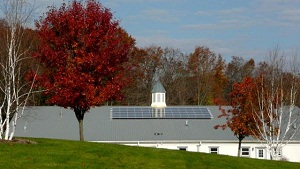Reviewing last week's solar energy news
 Last week saw a number of advances in the world of solar. California reached a milestone with 1 gigawatt of photovoltaics installed on roofs. PACE is getting a new lease on life in Florida. And a number of new technologies were announced.
Last week saw a number of advances in the world of solar. California reached a milestone with 1 gigawatt of photovoltaics installed on roofs. PACE is getting a new lease on life in Florida. And a number of new technologies were announced.
California reached an important milestone recently. There’s now more than 1 gigawatt of photovoltaics installed just on roofs in California. That means the state’s well on its way to meeting the goals of the Million Solar Roofs initiative. At this point, there’s enough rooftop solar in the state to power 750,000 homes—although some of the rooftop solar is on warehouses and other buildings.
Some of those buildings are IKEA stores. The company has been aggressive in adding solar to its stores in the U.S. Last week the furniture giant announced that more than half of all IKEA locations in the U.S. will have solar. That includes a distribution warehouse and administrative buildings. But by Spring 2012, the company plans to have solar on 23 of its U.S. buildings.
Property assessed clean energy (PACE) financing recently made headway in Florida. Fannie Mae and Freddie Mac decried PACE financing, which led many communities to reconsider such options. But now jurisdictions are signing up with Ygrene Energy Fund Florida to allow their residents to finance such projects. Ygrene established a line of credit with Barclay's Capital to support PACE projects.
New Jersey is the nation’s second largest solar market behind California, and it’s gaining on the state. But some say the state’s leadership is failing the industry. The state’s Sierra Club chapter director Jeff Tittel, is seeking court action to reverse some of the actions taken under Gov. Chris Christie’s (R) administration, which he says will hurt the industry and the Garden State’s environment.
The U.S. military now has a new option for going solar and has used it to sign a 20-year solar PPA (power-purchase agreement) for a 13.8-megawatt PV array being installed at the Naval Air Weapons Station at China Lake, Calif. The system is being installed by SunPower and will be owned by a MetLife subsidiary. Previously the military could only sign energy contracts for up to 10 years.
In the most far out solar news last week, a new report showed that we could soon set up giant solar farms—in space. The report from the National Space Society (NSS) and the International Academy of Astronauts found that orbiting solar power stations are feasible and perhaps just a decade away.
How about using the sun to clean up pollution while making fuel? That’s what HyperSolar’s planning to do. The company applied for patents for its photochemical natural gas-producing technology. Its nanoparticles mimic photosynthesis and can take dirty water and create hydrogen and other useful products from the waste stream. Hydrogen can be combined with carbon dioxide from a polluting source, creating methane.
Scientists also announced new technology advancements in other photovoltaics. Lawrence Berkeley National Laboratory researchers have produced a single-junction PV cell operating at up to 28.4 percent efficiency levels. And what’s unique about the cell is it becomes more efficient by emitting light.
Elsewhere, Caltech researchers are developing a solar cell that absorbs up to 70 percent of sunlight across the visible spectrum. The device uses nanoscale technology to trap light using optical resonance, like a solar sponge. The technology is being designed to integrate with thin-film PV.
Scientists at the University of California Santa Barbara said they were able to produce organic photovoltaics capable of reaching 6.7 percent efficiency after only a year of research. It’s a far cry from the 28.4 percent efficiency reported at LBL, but organic PV is inexpensive and can be used for temporary applications.
Image from ASES' National Solar tour gallery



